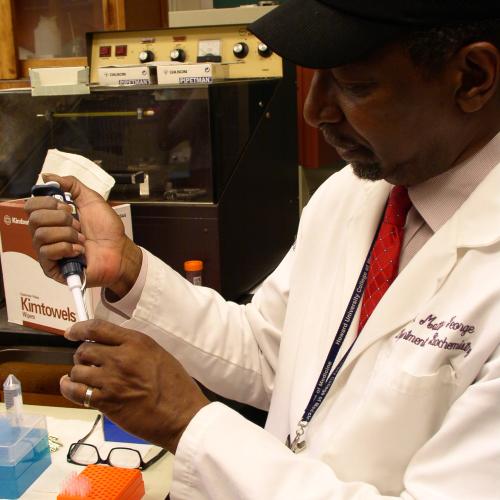B.S.
Biology
Wiley College

My days of active research are rapidly winding down. However, I still maintain a thirst for knowledge and scientific research. I now have interest in many areas of research. My research expertise and interests primarily revolve around regulation of gene expression, genetics, comparative biochemistry, and molecular evolution of mitochondrial DNA (mtDNA). I have been particularly interested in mtDNA in relation to evolutionary genetics and phylogenetic analyses. Utilizing mtDNA as an evolution tool, I have been involved in comparative/phylogenetic studies of: Old World Monkeys (established the rate at which mtDNA sequences change, which is ~10 times faster than single copy DNA); contributed to studies of different ethic human populations which led to the hypothesis of “Mitochondrial Eve” ; led mtDNA studies of 200 year-old human bones as a part of the “African Burial Ground Project at Howard University”; established the phylogenetic relationships of members of the Equus (horse) family which also led to the relationship of an extinct (quagga) horse species with today’s living horse species; and contributed to and studied the genetic relationship of the Northern and Southern White rhino, the results of these rhino studies are now part of conservation studies and efforts to save these severely endangered rhino species.
I have also studied various human diseases such as: breast cancer; HIV and AIDs; Leishmanisis; Lesch-Nyhan disease; leukemia; Chagas disease and transthyretin amyloid cardiomyopathy.
I also continue to find joy in participating in our Graduate Biochemistry laboratory course teaching hands-on molecular biology techniques designed for graduate students and working with my departmental colleagues on various research projects.
Biology
Wiley College
Microbiology/Biochemistry
Atlanta University (now Clark-Atlanta University)
Biochemistry
University of California, Berkeley
Teaching Activities
Desta Beyene, Tammey Naab, Victor Apprey, Luisel Ricks-Santi, Ashwini Esnakula, Mustafa Qasim, Matthew George Jr, Karen G Minoza, Robert L Copeland Jr, Carolyn Broome, and Yasmine Kanaan (2023) “Cyclin A2 and Ki67 proliferation markers could be used to identify tumors with poor prognosis in African American women with breast cancer” Journal of Cancer Biology, 4(1):3-16
Kevin F. Morris, Riley Geoghegan, Emily Palmer, Matthew George, Jr. and Yayin Fang*(2020) "Molecular Dynamics Simulation Study of AG10 and Tafamidis Binding to the Val122Ile Transthyretin Variant." Biochemistry and Biophysics Reports, 21, 100721
Charles O. Ogindo, Mozna H. Khraiwesh, Matthew George, Jr., Yakini Brandy, Nailah Brandy, Ayele Gugssa, Mohammad Ashraf, Muneer Abbas, William M. Southerland, Clarence M. Lee, Oladapo Bakare and Yayin Fang*. (2016) “Novel Drug Design for Chagas Disease via Targeting Trypanosoma cruzi Tubulin: Homology Modeling and Binding Pocket Prediction on Trypanosoma cruzi Tubulin Polymerization Inhibition by Naphthoquinone Derivatives.” Bioorganic and Medicinal Chemistry, 24, 3849 -3855.
F. L. C. Jackson, A. Mayes, M. E. Mack, A. Froment, S. O. Y. Keita, R. A. Kittles, M. George, K. J. Shujaa, M. L. Blakey, and L. M. Rankin-Hill (2009). “Origins of the New York African Burial Ground Population: Biological evidence of geographical and macroethnic affiliations using craniometrics, dental morphology, and preliminary genetic analyses”. In: The U.S. General Services Administration’s “The New York African Burial Ground: Unearthing the African Presence in Colonial New York, Volume I”; “The Skeletal Biology of the New York African Burial Ground, Part I”, (Michael L. Blakey and Lesley M. Rankin-Hill, editors). Howard University Press, Chapter 5, pp. 69-93
Traore, K., M. A. Trush, M. George, Jr., E. W. Spannhake, W. Anderson, and A. Asseffa. 2005. Signal transduction of phorbol 12-myristate 13 acetate (PMA)-induced growth inhibition of human monocytic leukemia THP-1 cells is reactive oxygen dependent. Leukemia Research. 29: 863-879
Dobbins, A.T., M. George, Jr., D. A. Basham, M.E. Ford, J. M. Houtz, M.L. Pedulla, J.G. Lawrence, G.F. Hatfull, and R.W. Hendrix. 2004. Complete genomic sequence of the virulent Salmonella bacteriophage SP6. Journal of Bacteriology. 186:1933-1944
Zarlenga, D. S. and M. George. 1995. Taenia crassiceps: Cloning and mapping of mitochondrial DNA and its application to the phenetic analysis of a new species of Taenia from Southeast Asia. Experimental Parasitology. 81:604-607
DeSalle, R., A.K. Williams and M. George.1993. Isolation and characterization of animal mitochondrial DNA. Methods in Enzymology. Molecular Evolution: Producing the Biochemical Data. 224:176-204
Higuchi, R.G., L.A. Wrischnik, E. Oakes, M. George, B. Tong, and A.C. Wilson. 1987. Mitochondrial DNA of the extinct Quagga: Relatedness and extent of post-mortem change. J. Mol. Evol. 25:283-287.
George, M. and O.A. Ryder. 1986. Mitochondrial DNA evolution in the genus Equus. Mol. Biol. Evol. 3:525-546
Brown, W. M., M. George and A.C. Wilson. 1979. Rapid evolution of animal mitochondrial DNA. Proc. Natl. Acad. Sci. USA 76:1967 -1971.